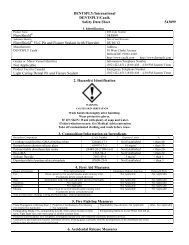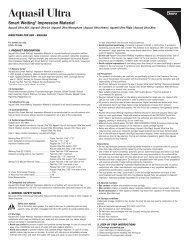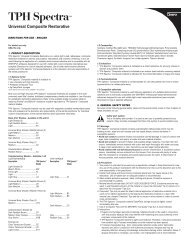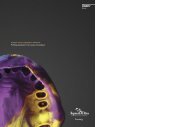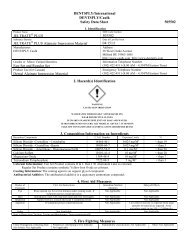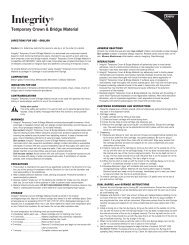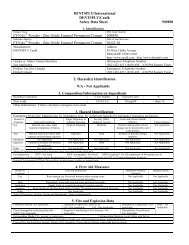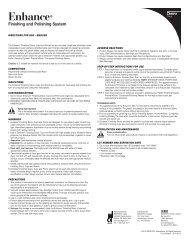Indirect and Direct Restorative Protocols - Caulk
Indirect and Direct Restorative Protocols - Caulk
Indirect and Direct Restorative Protocols - Caulk
Create successful ePaper yourself
Turn your PDF publications into a flip-book with our unique Google optimized e-Paper software.
› PRINCIPLES & PRACTICES<br />
<strong>Direct</strong> Resin Restorations:<br />
Considerations for<br />
Adhesive Bonding<br />
› Abstract:<br />
It is the obligation of the<br />
practitioner to provide the<br />
dental patient with the most<br />
aesthetic restoration using<br />
clinical techniques that<br />
ensure proper function,<br />
biocompatibility, <strong>and</strong><br />
preservation of sound tooth<br />
structures. Composite resin<br />
materials <strong>and</strong> adhesive bonding<br />
techniques are well suited for<br />
such concepts of conservative<br />
dentistry. Consequently, a<br />
thorough underst<strong>and</strong>ing of<br />
adhesive bonding procedures<br />
<strong>and</strong> knowledge of adhesive<br />
material options are<br />
prerequisites in contemporary<br />
dental practice.<br />
During tooth preparation for<br />
a direct resin restoration,<br />
residual organic <strong>and</strong> inorganic<br />
components form a<br />
“smear layer” of debris on<br />
the tooth surface. This barrier decreases the<br />
permeability of dentin <strong>and</strong> must be removed<br />
or made permeable so that resin monomers<br />
or adhesives can contact <strong>and</strong> interact with<br />
the dentin surface. Two fundamental strategies<br />
are used to overcome the smear layer:<br />
■ Total-etch: Adhesive systems with an<br />
acid gel to condition dentin <strong>and</strong> enamel<br />
surfaces, dissolving the smear layer<br />
<strong>and</strong> 1 µm to 6 µm of hydroxyapatite.<br />
■ Self-etch: Adhesives that treat the<br />
dentin <strong>and</strong> enamel surfaces with a<br />
non-rinsed solution of acidic monomers<br />
in water. These bonding systems<br />
make the smear layer permeable to<br />
subsequently applied monomers.<br />
Etch-<strong>and</strong>-rinse adhesives used in the totaletch<br />
technique involve separate etching <strong>and</strong><br />
rinsing steps, followed by the application of<br />
a hydrophilic primer <strong>and</strong>/or bonding resin<br />
to produce a “hybrid layer” or resin-dentin<br />
interdiffusion zone. With an etch-<strong>and</strong>-rinse<br />
adhesive, the prepared tooth surface must<br />
remain slightly moist after the etching gel is<br />
rinsed away. Overdried dentin must be rewet<br />
in order to raise the collapsed collagen to<br />
a level suitable for bonding.<br />
One-bottle, etch-<strong>and</strong>-rinse adhesives<br />
such as Prime & Bond® NT (DENTSPLY<br />
<strong>Caulk</strong>, Milford, DE) combine the primer<br />
<strong>and</strong> adhesive resin into a single step that<br />
achieves micromechanical interlocking of<br />
monomers with the collagen-rich etched<br />
dentin. The nanofiller technology of this<br />
material reinforces the hybrid <strong>and</strong> adhesion<br />
layer, protecting against microleakage <strong>and</strong><br />
postoperative sensitivity while establishing<br />
a proper marginal seal. Its combination of<br />
nanofillers <strong>and</strong> PENTA chemistry results<br />
in a material that eliminates postoperative<br />
sensitivity <strong>and</strong> ensures patient comfort.<br />
The chemistry of XP BOND Adhesive<br />
(DENTSPLY <strong>Caulk</strong>, Milford, DE), a universal<br />
self-priming adhesive, provides an<br />
extended working time <strong>and</strong> has a wider wetto-dry<br />
preparation tolerance than previous<br />
etch-<strong>and</strong>-rinse adhesives. Its ability to penetrate<br />
into the conditioned collagen network<br />
ensures the formation of an optimal bond.<br />
Figure 1. Preoperative view of defective fi lling that requires replacement<br />
with a direct composite resin restoration.<br />
Figure 2. Conservative cavity preparation is facilitated by adhesive-based<br />
approach that preserves sound tooth structures.<br />
29



